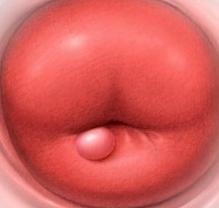 Nabotov cyst (another name - cervical cyst) - a pathology that is a small-sized formation of a rounded shape, inside which there is a secret.
Nabotov cyst (another name - cervical cyst) - a pathology that is a small-sized formation of a rounded shape, inside which there is a secret.
Dangers to life and health of a woman, this pathology in itself does not represent. However, it is worth highlighting the fact that the cyst on the cervix is the source of infection, which can become the main cause of infertility, and even lead to an ectopic pregnancy.
Nabotovy cysts are more common in women giving birth to childbearing age (from 20 to 45 years). Symptoms and treatment of this problem will be considered below.
Cysts on the cervix: causes
Why does the cervix cyst arise, and what is it? The cervix is the entrance to the uterus, it is located in the vagina. Through it there is a communication of a cavity of a uterus with a vagina and on the contrary. In its functions, it resembles a canal, one end of which (inner zev) leaves the uterus, and the second (external zev) - into the vagina. Inside the cervical canal there is a special secret that can destroy the infection and bacteria on the way to the uterine cavity.
But the quality of the contents of the secret may vary depending on the age of the woman and her cycle. The outer cervix is covered with a laminated epithelium of a flat type. The external pharynx is very different from the internal one. The middle part of the cervical canal is located between the two cervical outlets. It is a zone of transformation.
Diseases of the cervix arise when the cylindrical and flat epithelium are modified, that is, the cells of the flat epithelium are in the inner part of the uterus, and the cylindrical - in the outer.
The result of this modification is a decrease in immunity, inflammation and blockage of the Nabotov glands occurs, and cysts are formed. Cervical cysts have the form of medium-sized multiple or single tubercles of yellow-white color of medium density, the size of which is from 1 mm to 2 cm and more.
Factor of onset of occlusion of the glandcan be:
- Hormonal disbalance. The female organism in general always very sensitively reacts to a change in the hormonal balance.
- Not completely healed infection, when the course of therapy was terminated early.
- Occlusion may be a consequence of abortion, especially if the procedure has failed.
- Heavily passed birth.
- Mechanical damage, in the form of a stroke or injury.
If we touch the cervical cyst treatment, then we note that this process is not complicated, nevertheless, treatment necessarily, as well as an accurate diagnosis based on the results of not just a gynecological examination, but colposcopy.
Types of cysts
When the occlusion affects only one duct of the Naboth glands, the cyst is called solitary. But most often the duct of several glands is clogged, such cysts are called plural. Sometimes gynecologists resort to the term "paternal cysts" for the designation of multiple cysts. Multiple cysts occur much more often, but they themselves can be a consequence of self-healing of cervical ectopy.
In addition to single and multiple cysts, endometrioid cysts are isolated, in the cavity of which, in addition to the secret of the glandular glands, blood accumulates. They are characterized by a bluish color, the appearance of bleeding zones, which increase before the onset of menstruation.
Symptoms of cervical cyst
 It is noteworthy that most often a woman with a cervical cyst does not experience any discomfort or pain. Consequently, the cervical cyst symptoms are virtually absent.
It is noteworthy that most often a woman with a cervical cyst does not experience any discomfort or pain. Consequently, the cervical cyst symptoms are virtually absent.
If a woman has not visited a gynecologist for a long time and the disease has developed, then it can be determined by the following signs:
- bleeding not during menstruation,
- causeless pain in the lower abdomen,
- painful sensations during intercourse with a regular partner,
- any discharge from the vagina without excitation.
Identify the cyst can be:
- with colposcopy;
- when examining the uterus with a gynecological mirror.
The cyst is a white or yellowish-white rounded formation of a small size and medium density. Cervical cysts can be single, but most often there are multiple cysts.
Complications
The most frequent effects of cervical cyst (occur infrequently):
- Necklace infertility, when the endocervical glands grow, deform or completely block the cervical cavity.
- Abscess in the place of the blocked nasal glands due to suppuration of its contents.
- The threat of premature termination of pregnancy due to constant irritation of the cervix by numerous cysts (or one large cyst) located in the cervical canal.
- Deformation of the cervix due to a large number of cysts or due to a significant increase in the size of several cysts.
Cervical cyst: photo
How does this affliction look like in the photo?
Treatment of cervical cyst
It is widely believed that the cervix cyst is not particularly dangerous for the general condition of a woman and does not require treatment. Some specialists define the cyst as a normal state of health, which does not provoke complications.
Therefore, cervical cyst treatment treats the two main developmental processes.
- Some gynecologists believe that retention cysts must be removed, since it is possible to accumulate a purulent liquid inside the secretion.
- The latter insist that education should not be treated. And if there is a purulent fluid, it can be removed by puncture, which continues with a drug therapy, the affected area is treated with Surgitron, a special healing drug.
Treatment of a cyst does not require a hospital stay. After 7-10 days, the use of candles is prescribed to speed up the healing process.
Surgery
With single cysts, their complete removal is possible in several ways:
- Laser Removal. Laser impact is less traumatic than others, it allows you to pinpoint the smallest foci.
- Cryodestruction(the effect of low temperatures).
- Coagulation(cauterization of the cyst).
- Mechanical removalcysts of the cervix by conization. If the cysts are large, they cause many inconveniences and prevent the onset of pregnancy, then the cone of the cervix is performed, that is, the cutting of its inner layer.
Apparently, today medicine has several ways to get rid of the cyst of the uterus. The most suitable for the patient option should be selected by the doctor, not feedback on treatment on the Internet.
The operation should not cause complications. The only thing that is possible is an uncomfortable aching pain in the lower abdomen, which should pass in 1-2 days, and also not abundant bloody discharge.
Postoperative period
Surgery to remove cysts is carried out on an outpatient basis. After the procedure, which takes a few minutes, you can go home. Within two to three days after the operation, small bloody discharge may occur, the stomach can pull, as in the beginning of menstruation. Normally, yellow discharge lasts about seven days.
Do not forget to visit a gynecologist in a month, to control the healing of the surgical site.

How to choose probiotics for the intestine: a list of drugs.

Effective and inexpensive cough syrups for children and adults.

Modern non-steroidal anti-inflammatory drugs.

Review of tablets from the increased pressure of the new generation.
 Antiviral drugs are inexpensive and effective.
Antiviral drugs are inexpensive and effective.



